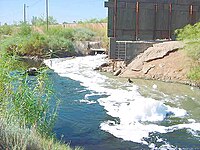
Photo from wikipedia
Many states are adopting more stringent nutrient load restrictions, requiring utilities to invest in costly improvements. To date, substantial research has been done to independently assess the nutrient removal efficacy… Click to show full abstract
Many states are adopting more stringent nutrient load restrictions, requiring utilities to invest in costly improvements. To date, substantial research has been done to independently assess the nutrient removal efficacy of wastewater treatment technologies and stormwater control measures. The analysis presented here provides a unique assessment by evaluating combinations of nutrient load reduction strategies across water supply, wastewater, and stormwater sectors. A demonstration study was conducted evaluating 7812 cross-sector removal strategies in the urban water system using empirical models to quantify efficacy of common wastewater treatment, water management, and stormwater control measures (SCMs). Pareto optimal solutions were evaluated to identify the most cost-effective strategies. To meet stringent nutrient requirements, wastewater treatment facilities (WWTFs) will likely require advanced biological nutrient removal with carbon and ferric addition. Even with these technologies, WWTFs may still be unable to obtain target nutrient requirements. In addition, municipalities can consider water management practices and SCMs to further reduce nutrient loading or provide a more cost-effective nutrient removal strategy. For water management practices, source separation and effluent reuse were frequently identified as part of the most effective nutrient strategies but face engineering, political, and social adoption barriers. Similarly, SCMs were frequently part of effective nutrient removal strategies compared to only adopting nutrient removal practices at WWTFs. This research provides the framework and demonstrates the value in using an urban water system approach to identify optimal nutrient removal strategies that can be easily applied to other urban areas.
Journal Title: Journal of environmental quality
Year Published: 2020
Link to full text (if available)
Share on Social Media: Sign Up to like & get
recommendations!